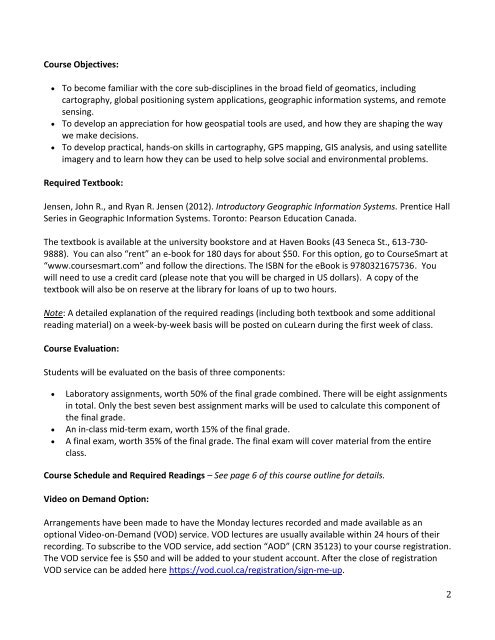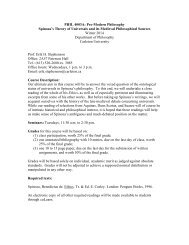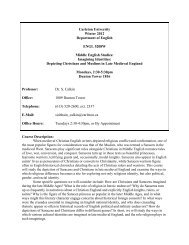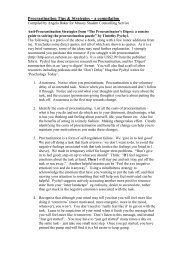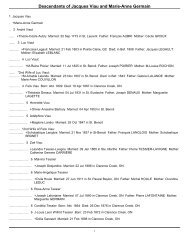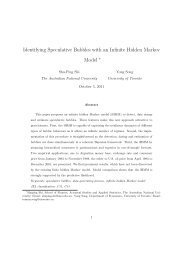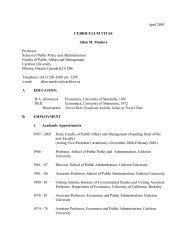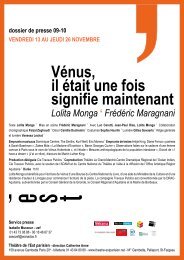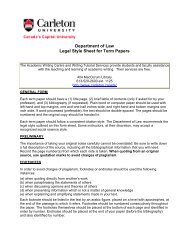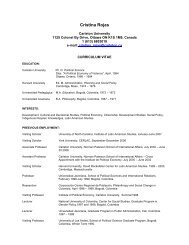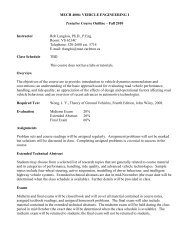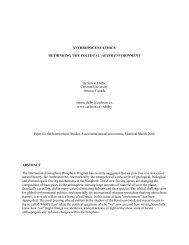Course Objectives: To become familiar with <strong>the</strong> core sub-disciplines in <strong>the</strong> broad field of geomatics, includingcartography, global positioning system applications, geographic information systems, <strong>and</strong> remotesensing. To develop an appreciation for how geospatial tools are used, <strong>and</strong> how <strong>the</strong>y are shaping <strong>the</strong> waywe make decisions. To develop practical, h<strong>and</strong>s-on skills in cartography, GPS mapping, GIS analysis, <strong>and</strong> using satelliteimagery <strong>and</strong> to learn how <strong>the</strong>y can be used to help solve social <strong>and</strong> environmental problems.Required Textbook:Jensen, John R., <strong>and</strong> Ryan R. Jensen (2012). Introductory Geographic Information Systems. Prentice HallSeries in Geographic Information Systems. Toronto: Pearson Education Canada.The textbook is available at <strong>the</strong> university bookstore <strong>and</strong> at Haven Books (43 Seneca St., 613-730-9888). You can also “rent” an e-book for 180 days for about $50. For this option, go to CourseSmart at“www.coursesmart.com” <strong>and</strong> follow <strong>the</strong> directions. The ISBN for <strong>the</strong> eBook is 9780321675736. Youwill need to use a credit card (please note that you will be charged in US dollars). A copy of <strong>the</strong>textbook will also be on reserve at <strong>the</strong> library for loans of up to two hours.Note: A detailed explanation of <strong>the</strong> required readings (including both textbook <strong>and</strong> some additionalreading material) on a week-by-week basis will be posted on cuLearn during <strong>the</strong> first week of class.Course Evaluation:Students will be evaluated on <strong>the</strong> basis of three components:Laboratory assignments, worth 50% of <strong>the</strong> final grade combined. There will be eight assignmentsin total. Only <strong>the</strong> best seven best assignment marks will be used to calculate this component of<strong>the</strong> final grade.An in-class mid-term exam, worth 15% of <strong>the</strong> final grade.A final exam, worth 35% of <strong>the</strong> final grade. The final exam will cover material from <strong>the</strong> entireclass.Course Schedule <strong>and</strong> Required Readings – See page 6 of this course outline for details.Video on Dem<strong>and</strong> Option:Arrangements have been made to have <strong>the</strong> Monday lectures recorded <strong>and</strong> made available as anoptional Video-on-Dem<strong>and</strong> (VOD) service. VOD lectures are usually available within 24 hours of <strong>the</strong>irrecording. To subscribe to <strong>the</strong> VOD service, add section “AOD” (CRN 35123) to your course registration.The VOD service fee is $50 <strong>and</strong> will be added to your student account. After <strong>the</strong> close of registrationVOD service can be added here https://vod.cuol.ca/registration/sign-me-up.2
Once subscribed, <strong>the</strong> VOD service can be accessed from https://vod.cuol.ca/vod. Access to individuallectures on a Pay-Per-View basis can also be obtained from this site.Please note: <strong>the</strong> purpose of offering VOD service for lectures is to allow students to view lectures thatare missed due to illness or o<strong>the</strong>r reasons beyond <strong>the</strong>ir control, <strong>and</strong> to allow students to review lecturematerial in preparation for <strong>the</strong> mid-term <strong>and</strong> final exam. It is not intended as a replacement forattending lecture.Purpose of Lectures, Readings <strong>and</strong> Assignments:The lectures, readings, <strong>and</strong> laboratory sessions <strong>and</strong> assignments are designed to complement <strong>and</strong>reinforce each o<strong>the</strong>r in meeting <strong>the</strong> course’s learning objectives. Class lectures provide <strong>the</strong>fundamental structure for <strong>the</strong> course, including <strong>the</strong> presentation of key concepts <strong>and</strong> issues, casestudies, audiovisual material, <strong>and</strong> additional content not found in <strong>the</strong> textbook. The required readingsin <strong>the</strong> textbook provide an overview of course topics, fur<strong>the</strong>r examples, <strong>and</strong> additional material notaddressed in class lectures. The laboratory assignments provide <strong>the</strong> opportunity to apply key methods<strong>and</strong> concepts introduced in <strong>the</strong> lectures <strong>and</strong> readings. An underst<strong>and</strong>ing of both class lecture material<strong>and</strong> required readings are needed to complete each assignment successfully.The mid-term exam <strong>and</strong> <strong>the</strong> final exam will include material from <strong>the</strong> required readings <strong>and</strong> classlectures, including audio-visual materials. Course content that is exclusive to <strong>the</strong> laboratory sessionswill not be included in <strong>the</strong> exams. A cuLearn web site for this course has been made for students. Hereyou can access <strong>the</strong> course outline, lecture slides, assignment grades, occasional announcements, <strong>and</strong>contact information <strong>and</strong> office hours for <strong>the</strong> instructors <strong>and</strong> teaching assistants (TAs). To log in, go tocuLearn at https://cuLearn.carleton.ca/. Lecture slides will be posted on cuLearn for your reference.Please note that lecture slides provide only a partial summary of <strong>the</strong> lecture material presented inclass. Past experience indicates that class attendance has a significant impact on scores on <strong>the</strong> midterm<strong>and</strong> final exams.Learning Support Services Incentive ProgramThis course has been registered in <strong>the</strong> study skills Incentive Program offered through Learning SupportServices (LSS), which gives you an opportunity to earn bonus marks for your final grade. For each StudySkills workshop you attend throughout <strong>the</strong> term, you will earn a 1 percent bonus mark, up to amaximum of 5 percent. If a student has not completed 5 workshops by end of term, LSS will notprovide a 1-on-1 session as a substitution. (Please note that it is <strong>the</strong> student’s responsibility to sign infor workshops, if you do not sign <strong>the</strong> attendance record, you will forfeit <strong>the</strong> bonus mark for yourworkshop participation.) The goal of attending study skills workshops in LSS is to exp<strong>and</strong> <strong>and</strong> refineyour academic skill set. There are 15 different workshops to choose from. Topics include: AcademicReading, Balancing Work <strong>and</strong> School, Critical Thinking, Note-Taking in Lectures, Preparing for Exams,<strong>and</strong> Writing Reports, among o<strong>the</strong>rs. Workshops will become available starting September 16 <strong>and</strong> mustbe completed by November 29 to receive credit for <strong>the</strong> Incentive Program. You will need to bring your<strong>Carleton</strong> ID card with you to each workshop.3


